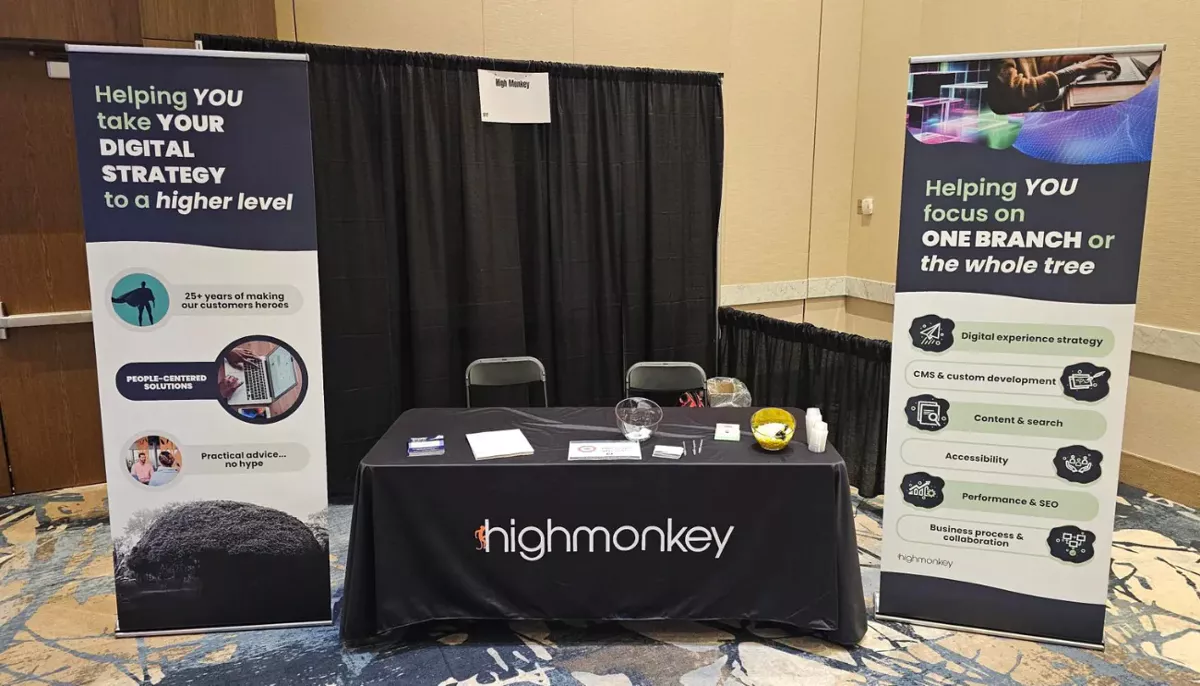
BLOG
Imagine Your Collaborative World without...Executives!
I decided last month that I would start writing blog posts with actual content. So, I thought I would kick off a new series of posts that both fit my personality and address some of the business problems I see out on the SharePoint highway on a regular basis.
August 8, 2010
Reading time: 10 min
|
Digital Experience Strategy
So I thought I would start a series of posts that looked into these roadblocks and provided some strategies, both high level and specific, to move past them, or better yet…bring them along for the ride! SharePoint projects tend to be unique implementations in most organizations. They're unique in the sense that they can have such a wide variety of users whom access it for so many different reasons. Depending on how your organization is set-up, it could just be a few or even several thousand people that use the same information, work through the same processes and need to touch your systems on a daily basis. With all of these different users and processes, come many different opinions and agendas.
In the world of a consultant, I am constantly bombarded with people's perceptions of different work environments and how their needs fit into the overall business equation. Much of my job is to understand these nuances in order to help an organization make some modicum of sense out of it and how it translates to a collaborative environment such as SharePoint. In doing so, it seems there is always someone or something that stands in the way of making a good system even better (or even getting a project started). This could be someone standing in the way of getting the money needed for a project (you had to know this would be first on a consultant's list J), not providing you with the direction you need, or setting unrealistic expectations around the project. Whatever the case, frustrations come from someone causing our job to be harder than it should be. Now that we've identified WHAT tends to create problems, the next question is WHO? The answer to this question can vary greatly depending on your situation.
So my thought was, why not write about all the different roles in a company, what part they play in the big picture, and how different our collaborative worlds would be without that role. Depending on the company you work for and your specific role, your problems could come from many directions. It could come from the executive level, the IT administrator level, the end user level, or a vast number of other roles! I'm sure you can pick at least one role in your company that you feel you could live (better) without. I will take some time to explore this dream land with each new blog post in the series. While this imaginative exploration might be fun to travel, it isn't going to help us accomplish anything unless we come back to reality. Since these roles and positions do exist in the real-world, we need to be able to effectively manage our relations with them. My goal with this series of blog posts is to provide some entertainment, but more importantly giving you some ideas around how you can improve your collaborative relationships and in doing so benefit your collaborative world.
As you might've guessed from the title, the first of this series will help you, "Imagine Your Collaborative World without Executives!" In my experience, especially when working on IT driven projects, the number one frustration I always hear is how 'out of touch' executives are. This phrase is usually associated with some type of goal a person is trying to accomplish that is being impeded by their executive(s). The title "executive" can cover a broad spectrum of functions, but for the purpose of this post, we will consider executives those that at the highest level of an organization. Depending on the size of your company and your personal role within it, these may be people you personally know or maybe just names you hear referenced and see in company news. These are the people who have the ultimate say on business direction and the most important part of any project…funding.
So, what would your collaborative life be like if there were no executives in the world? For some, this might be something you imagine on a daily basis. Imagine…
- No more ROI analysis, PowerPoint presentations, justifications, or having to be the voice of reassurance.
- You wouldn't have to listen to another suggestion made based on an article or TV news report (or even worse "my [insert important relative or friend here] was telling me about…").
- You wouldn't have to listen to responses to suggestions such as, "I don't know why, but I just don't like that" OR can you "dumb it down for me."
- You could almost eliminate the approval bottleneck (because you wouldn't have to ask) and have an unlimited budget (as long as the money kept growing on trees).
- Plus, you'd have time to get YOUR work done. No more interruptions mid-project or shifting gears every 5 minutes for executive mind-changing.
I have worked with many clients who tell me I will be dealing with an executive who is a 'tough sell' or 'just doesn't get it'. I used to prepare for the worst and 'arm myself for battle', thinking the project could be lost before it even starts. To my surprise, I often found it wasn't the executive being against the project, but they actually just didn't understand it. This isn't because the executive is not smart. It is usually due to a misunderstanding and/or miscommunication of the project or perhaps your world, and they might not want to admit it (one does not get to be an executive without having an ego J). Most executives don't enjoy the fact there are certain topics (especially technology) that are outside their comfort zone. Through my many, many meetings with executives from all different levels and organizations, I have found most react to their own confusion about technology with negativity towards it application. Too many times we assume 'just because I know, so do they'. So what can YOU do when you have a difficult executive to deal with? Well here are some great tips to help you out.
The Shut up Principal
First and foremost you can employ the skill of 'listening.' Listening tends to be a skill that most overlook as a valuable quality. We may be skilled at providing a compelling narrative around our projects, but often times forget to listen to other opinions or even more important…their criticisms. Being able to listen can go a long ways in making a given situation a success. What frequently happens is as people are "listening," they spend more time formulating their response instead of actually hearing what the person is saying. Try putting extra effort into listening to what your executive is really saying. Then, ask well thought out questions to gain a better understanding of their perception. This will give you a much better ability to identify and address what has been miscommunicated or misunderstood. I have been in many situations where an executive shares a concern, which is then followed by a retort from the project lead on why their concern is invalid. Instead of using this method, try taking the approach of asking more questions around the concern and identifying how your project plans can address it. I have found that executives usually do not want to derail a project; they just want their concerns heard. Good listening skills can move you a long ways down the road to project success. Try thinking in their shoes so you can come to meetings armed with rebuttals that explain how your project will positively impact their work and their world. Mistaking their CrackBerry for Tech Savvy Ohhh, the invention of the cell phones and other cool gadgets. I don't know how many times I have walked into situations where project leads assume the people they work with have knowledge about technology that they don't really have. Most of this assumption comes from the mass consumption of 'ready tech' and our interpretation that people are more tech savvy than they are. What we don't consider is the nature of the technology they know how to use. These devices are meant to be easy to use, therefore very simplistic in nature. How hard is it to answer a call, check an email or press a button that says 'GO'? These are the types of tasks that most people know and use to color their perspective on technology. I think one of the most common statements I have heard in countless boardrooms, which highlights this fact is: 'I would like to see our search work like Google'. (My typical answer being 'give me 6 billion and a few years…') It is statements like that which show just how out of touch most people are with technology.
Most systems, like SharePoint, are complex at their heart. SharePoint in particular is a hard concept for people to get their heads around. Especially when you consider all the new technologies and added features (SharePoint 2010 is a perfect example of this). If you are going to talk tech with someone outside your group and be successful, you are going to need to understand how confusing this technology can be and adjust your verbiage accordingly. Being TOO in touch Executives are big picture people and whether you agree or not, the big picture is crucial to an organization's success. The problem with being a big picture person is sometimes the details get lost or ignored, and often that is where our frustration lies. When you sit down with executives to make your pitch, you often see an executive looking at how projects affect Company Goal A, while your just trying to accomplish your department's little goal B. You, on the other hand, might be the opposite, often getting caught up in the details too much. You see your specific need and how to accomplish it, but you either don't want to realize or don't care to realize how it fits into the bigger picture. The reality is you are on two opposite sides of the same coin. Understanding differing perspectives can help you devise a pitch that reflects both sides instead of just your own. So instead of coming to a meeting only prepared to defend your position, try coming prepared to show how your project aligns with the overall company direction. Get executive buy in up front Having executive buy-in can prove to be an invaluable asset. Too often I see IT groups that try to bypass the executive levels by 'sneaking' a project through. In the short term this may seem to be the easiest way to get a project accomplished, however this can be a crucial mistake in the long run as executive buy-in is paramount to obtaining and maintaining the funding and resources needed to keep a SharePoint environment running. In my experience, most IT projects tend to fail because of their shortsightedness, which is usually either a consequence of poor planning or bypassing internal processes that end up being critical to success down the road. A good example of this principle is one of the most important aspects of project methodology…flexibility.
Implementing a system such as SharePoint, which by its nature can be flexibility personified, loses a lot of that tractability if you can't get approval to bring in experts (both internal and external) to bend and shape the system when needed. If I could only count on one hand the number of times I have been invited into organizations with thousands of users and only 2-3 SharePoint people. This imbalance is typically because these projects have been done without getting executives to buy in and really understand the benefits or complexity of what is being served. When you get executive buy in upfront and keep the execs happy (or even make them your champions), you'll be able to sustain the long term flexibility that SharePoint offers, making it a win-win situation. Keep in touch Involve executives in the ENTIRE process. If you know you are going to need executive budget approval, don't spring it on them. I don't know how many times I have done presentations for executives that did not have a clue about the project I was presenting on. Involving executives in your early communications or inviting them to the initial meetings can go a long way. I know what you are thinking…"but they won't come!" or "they won't read it!" Well, that may be true, but just inviting and exposing them to the process can start warming them to an idea early on. Though many execs won't admit it, you'd be surprised how many actually pay attention and will try to prepare in advance for technology discussions.
On the flip-side, I have seen some nasty reactions from executives who have been totally unprepared for what they were getting ready to hear. Easing them in and keeping them informed through a good communication will be a big win-win. Bring alternatives Often times you find executives asking for things to be cheaper, require less resources and take less time. These reactions usually come from concerns around budget, the notorious IT project 'scope creep' and their desire to squeeze every ounce of the dollar out of every project. Where this can often be very frustrating to you, most reactions employ one of two strategies: the 'it won't work' strategy or the 'head shake.' Those that employ the first often immediately have at least 5 reasons that implementing their project as planned is the only way it will work. This strategy often fails for the sole reason that you completely discarded the executive's needs by only rationalizing your own. For those that use the second strategy, their heads begin to shake in a 'yes' motion as soon the question is asked. 'Yes, we can cut the budget', 'Yes, we can get the project done faster'…this is what the executive wants to hear, it often causes project failure or issues down the road because you will be attempting to deliver the same project with less than the necessary time and money. Plus, once an executive realizes how amenable you are to cuts, wait until next time and see what he/she asks.
A better way to deal with these kinds of situations is to always come prepared with alternatives to your proposal. Being one dimensional in our project thinking paints us into a box, while having some alternatives to address potential complications can help ensure success. In addition to suggesting possible alternatives, it is even more important to explain how each alternative will affect the overall project…'Yes, we could cut 20% of the project costs, but this would take out feature X and increase the time of project delivery to Y.' I have dealt with a lot of executives and they always want to save time and money, but the reality is, if you help them understand what trade-offs they will have to make in order to cut costs and time, they will usually end up agreeing that the proposed plan is in fact the best. Another strategy, for the brave of heart, is to ask the executive what specific parts of the project they would like cut out…'Yes, we could cut 20% of the project costs, what 20% of the project matter would you also like to cut?') So now that I've talked about a lot of general tips, let me share with you just a few specific ideas on how you can make your dealing with executives just a little easier.
Don't be afraid to bring in the outside experts that understand what you're doing and the process involved. This gives executives a high level of confidence and reassurance that you're implementing best practices. I mean really, how many times have you seen an executive agree with a suggestion from an outsider that you've had 50 times yourself!? I am always amazed at how internal voices can often times seem to fall on deaf ears, while an outside voice is like someone 'singing from the rooftops'. Also, these outside experts don't necessarily have to be consultants ([Insert consultant joke here]). I have worked with many organizations that invite colleagues from other organizations that might already have the solution they are trying to implement, to sit down with their group and help define a strategy to 'sell' that solution. Learn to golf. Ok, maybe you don't have to do that, but overall make some effort to relate. Finding common ground with someone doesn't need to just be around work projects. Often times a stronger, more personal bond is established through finding common hobbies or activities, talking about places travelled or the sports teams we both love (or hate). Finding that common ground can be one of the biggest wins of all. Not only do you share a common interest, but your name has now been attached to something they like and enjoy, not just an image of your hand out J Go to lunch or set up a one on one meeting with an executive, rather than just bringing things up in a work meeting with others around. Executives may not have expertise or "the know" on some subjects. As I discussed earlier, if it's brought up in a meeting in front of everyone and the executive is 'confused', defense mechanisms might kick-in and you'll get shot down for all the wrong reasons. Take the time to crunch the numbers. Be reasonable and realistic. Start small and work your way up in increments. IT projects often get killed by overenthusiasm. How do you crunch the numbers? Well there are some great resources out there on the web. One of my personal favorites is Paul Culmsee and his Clever Workarounds blog (www.cleverworkarounds.com/), who does great work in providing ROI formulas for SharePoint installs. Check it out.
Though we might like to imagine our lives without executives, in reality they exist and are critical to making our collaborative projects a success. So don't get frustrated and give up before the battle has even started. Take a few of these practical tips and discover a new approach to making life WITH executives a breeze! (at least as much as it can be)
Latest Blogs

| CMS & Custom Development
Using AJAX and MVC for Filtering and Paging a Directory
Learn how to build a dynamic resource directory with AJAX and MVC, featuring filtering and paging for a seamless user experience.
June 5, 2025
Reading time: 8 min

| Inclusive Design
Why Accessibility Isn’t Optional: Celebrating GAAD at High Monkey
Recognizing Global Accessibility Awareness Day with resources, insights, and episodes from our podcast that promote inclusive digital experiences.
May 15, 2025
Reading time: 3 min

| News
High Monkey at ACCELERATE 25
High Monkey had a blast at ACCELERATE 25! See what we shared, who we met, and how we’re helping credit unions improve their digital experiences.
April 24, 2025
Reading time: 2 min
Your success story starts here
Contact us for a free consultation, and let’s work together to build a strategic plan that tackles your challenges and lifts your organization to a new level.

